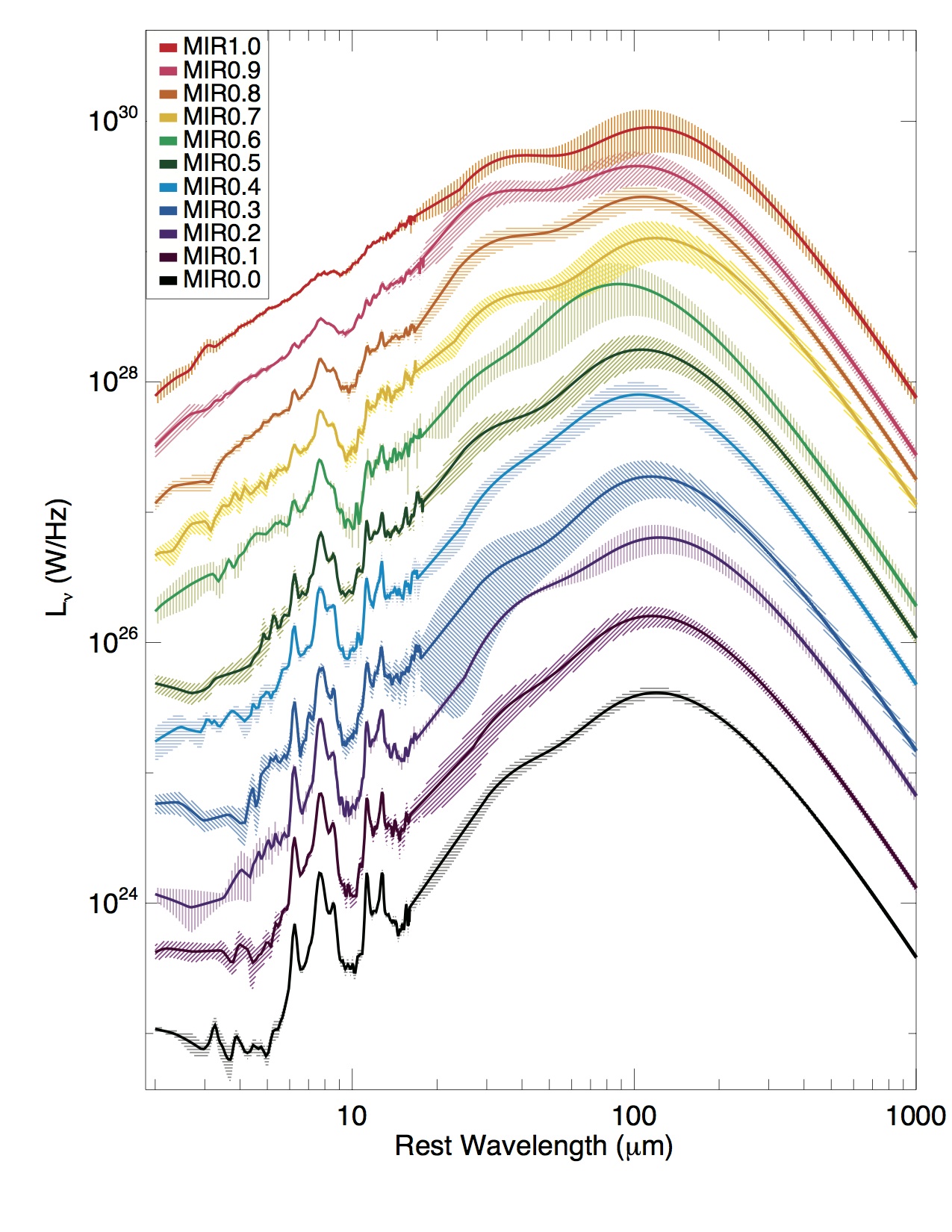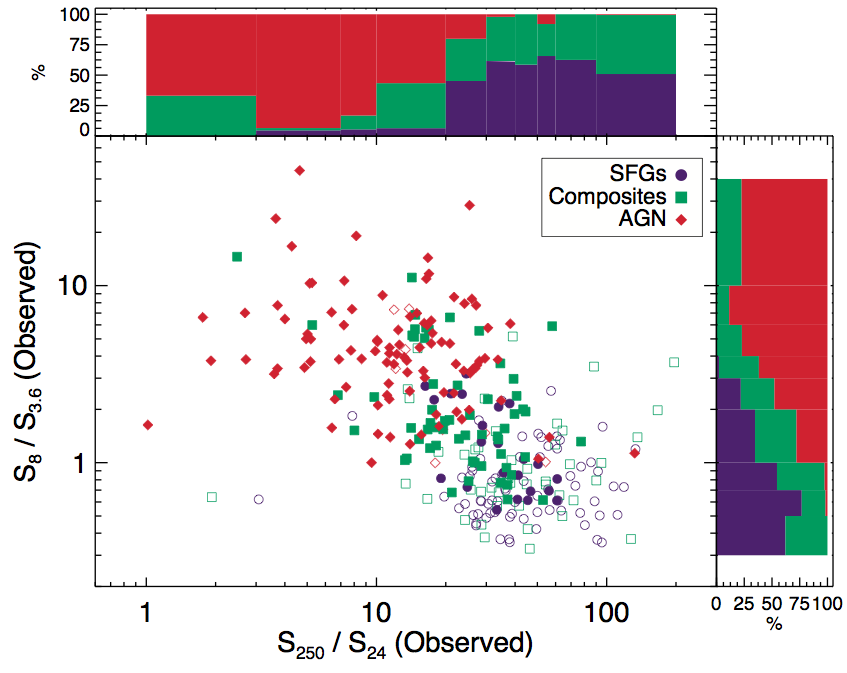
A library of publicly available templates from Kirkpatrick et al. (2015). I have sorted 343 galaxies into subsamples based on how much the AGN continuum contributes to the mid-IR luminosity (0.0 means no contribution, 1.0 means 100% of mid-IR luminosity is due to continuum emission). I then average the individual SEDs together to create each empirical template. These are ideal for use with z=0.3-2.8 IR sources.
This is an exciting time to be an infrared astronomer. In the past decade, space telescopes and large survey programs have revolutionized our understanding of the infrared emission from dust. Now, we are crossing the threshold of a new era with the impending launch of the James Webb Space Telescope. My research up until now has centered around data from the Spitzer Space Telescope and the Herschel Space Observatory, and is particularly relevant in the age of JWST. Below, I summarize three key eras of past research. (One thing that might also be evident on this page is my enjoyment in making very colorful figures!)
Infrared Spectral Energy Distributions
Luminous Infrared Galaxies (LIRGs) and Ultra Luminous Infrared Galaxies (ULIRGs) dominated the star formation rate density around "cosmic noon" (z~1-2). These galaxies appear to be a unique class, rather than analogs to local ULIRGs. I have characterized the IR emission of these galaxies in detail (Kirkpatrick et al. 2012, Kirkpatrick et al. 2015) using a sample of 343 (U)LIRGs from GOODS and xFLS fields. What makes my sample unique is that I have mid-IR spectroscopy for every galaxy. I use this spectroscopy to find hidden, dusty AGN by decomposing the individual spectra into a star formation and AGN-continuum component.
Many of our individual SEDs are poorly sampled, due to detection limits or confusion limits in the far-IR. I have classified sources according to the AGN emission in their mid-IR spectra, as well as redshift and luminosity, and averaged individual SEDs to create publicly available templates. The templates from Kirkpatrick et al. (2015) are here. Previous templates from Kirkpatrick et al. (2012) are here. These templates are ideal for use with high redshift, infrared detected sources. They can be used to estimate LIR, submm flux, AGN emission, and more.

Observed frame colors. SFGs (blue), composites (green), and AGN (red) were defined with mid-IR spectroscopy. AGN and SFGs separate cleanly in both colors (distributions are shown on the top and right) making this color diagnostic advantageous for selecting buried AGN or pure SFGs at high redshift.
Color Diagnostics
The best method of AGN selection is a hot topic these days. I've designed (yet another) color technique for selecting IR AGN which I created using 343 high redshift (U)LIRGs with mid-IR spectroscopically identified AGN. My method selects a slightly different sample than IRAC color diagnostics because I combine two colors (S250/S24 and S8/S3.6) that span the entire IR SED, providing the most detail about the shape of a source's IR spectrum. An added benefit of using a color that combines far-IR and mid-IR photometry is that it is indicative of the power source driving the IR luminosity. AGN have significantly redder S250/S24 colors than star forming galaxies (SFGs) due to heating from an AGN boosting the mid-IR emission. This technique is more sensitive than IRAC color selection for composite sources that may have boosted mid-IR emission but still have a visible stellar bump. My color selection technique is discussed in detail in Kirkpatrick et al. (2013a) and Kirkpatrick et al. (2015).

Correlation between SFR/L500 (SFR normalized by dust mass) and cold dust temperature, Tc, for resolved regions in 20 local star forming galaxies. The trend with Tc indicates that photons from star forming regions are primarily responsible for heating the diffuse ISM.
Far-IR Dust Heating
I have also spent some time exploring dust closer to home: a sample of local star forming galaxies from Key Insights on Nearby Galaxies: A Far-IR Survey with Herschel (KINGFISH). I modeled the far-IR/ submillimeter SED on a resolved scale (0.1-3 kpc; Kirkpatrick et al. 2014a). I compared the measured cold dust temperature, Tc, and dust emissivity, β, with possible heating sources. Far-IR dust emission has two main heating sources: young stars (which I traced using the star formation rate, SFR) and the old stellar population (I used the luminosity at 3.6μm, L3.6, as a tracer). When I normalize the heating sources by the dust mass surface density (traced by 500μm luminosity, L500), I find a significant trend between SFR/L500 and Tc. I interpret this to mean that the flux of UV photons relative to the amount of dust is significantly contributing to the heating of the cold, or diffuse, ISM. I also see a trend between L3.6/L500 and β, demonstrating that the old stellar population contributes to the heating at far-IR/ submillimeter wavelengths.

